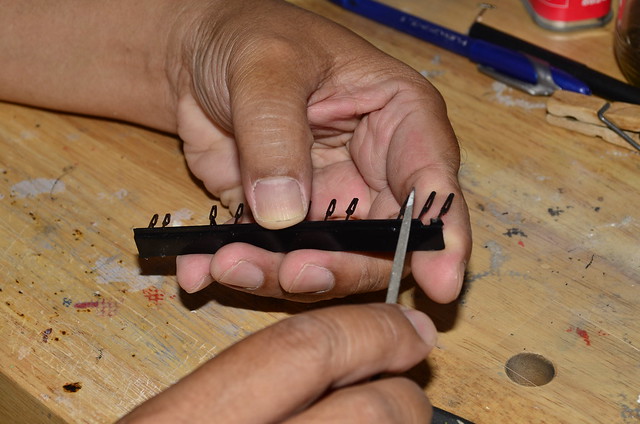The Channels
The Bluejacket kit comes with a strip of wood specifically intended to be used to form the channels. I was planning to create 2 sets of channels, one from the wood from the Bluejacket kit, and one made from the plastic parts of the Revell kit, and then go with whichever one I liked better. I used the plastic channel as a template for the wooden one. Upon carving the basswood, I found a few things. 1. Wood is a lot harder to carve than plastic. 2. wood is a lot harder to carve than plastic. I got the feeling that no matter how much I carved the wood, it would be hard to get the inside surface of the channel to match as perfectly as the plastic one already does. I was planning on inserting brass rod into the wood, drilling matching holes through the hull, and attaching the channels, but in the end, I decided that no matter how well I carved the wood channels, the join between them and the hull would not be as strong as the original plastic melded to the hull with plastic solvent cement, so I chose to work with the Revell channels.
I took the existing chains underneath the Revell channels and using them as a guide, I carved in some rectangular notches with a needle file, where the deadeye strops would eventually go, then snipped off the chains and filed the nubs down.
 _DSC8075 by Jose Gonzales, on Flickr
_DSC8075 by Jose Gonzales, on Flickr
Originally, I tried CA gluing the strops into the notches, planning later to glue a styrene strip on the outside edge of the channel to lock the strops in, but the CA did not hold the strops in well at all, and any pressure I placed on the strops disconnected them (the tube of CA possibly was old, and may have lost its holding power). I switched tactics, gluing the styrene strip on the edge before adding the stropped deadeyes. I also added a strip to fill in the recessed area where the Revell deadeye assembly would normally have been glued atop the channel.
 _DSC8078 by Jose Gonzales, on Flickr
_DSC8078 by Jose Gonzales, on Flickr
I then inserted the stropped deadeyes, added the chain link to the stem/loop below, and soldered the link shut. A couple of eyebolts were added for the Bentink shrouds and topsail halyards. All this was done before the channel was attached to the hull.
Note that for the fore and main masts, the deadeyes for the shrouds are 5/32 inch dia, while the deadeyes for the backstays are 1/8 inch dia.
Jose Gonzales
San Diego, CA